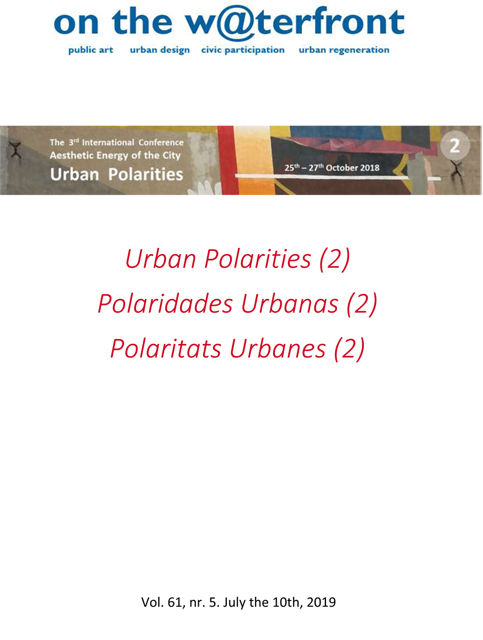Art de carrer i patrimoni immaterial: un enfocament contextualitzador de l'art públic a Vitòria-Gasteiz.
DOI:
https://doi.org/10.1344/waterfront2019.61.6.6Paraules clau:
treball de camp etnogràfic, Vitòria-Gasteiz, País Basc, Capital verda europea, Projecte IMVG, Projecte Open for Works, Ken Follet, sostenibilitat, pràctica comunitària, compromís social, participació pública, Art de carrer, galeria urbana, art muralResum
Aquest article presenta els resultats del treball de camp etnogràfic dut a terme a la ciutat de Vitòria-Gasteiz, capital del País Basc, entre el 4 i el 8 de desembre de 2017. A la darrera dècada, Vitòria-Gasteiz és coneguda internacionalment gràcies a la seva urbanització. galeria de l’art mural mural públic. Els murals de Vitòria-Gasteiz, de fet, van ser un dels principals atractius de la ciutat quan va obtenir el reconeixement de la Capital Verda Europea el 2012. Van començar a ser produïts pel projecte IMVG el 2007 sobre les mateixes bases de la sostenibilitat que el general agenda de la ciutat. Aquesta agenda cultural es va convertir en un referent de primer ordre en el camp dels estudis sobre patrimoni cultural, gestió i arqueologia de l’arquitectura gràcies al projecte Abierto por Obras que va integrar la sostenibilitat en els processos de recerca i desenvolupament de l’excavació, restauració, reparació , consolidant, documentant i exposant la catedral gòtica de Santa Maria mitjançant la interpretació cultural. Aquest programa es va convertir en un exemple de bones pràctiques reconegudes internacionalment i atraient gent com Ken Follet, que va presentar A World without End, la seva seqüela de The Pillars of Earth, a l’edifici. L’èmfasi en la sostenibilitat fa que l’IMVG sigui un cas excepcional en el món actual de l’art de carrer, on normalment les expressions solen ser més efímeres. Un dels aspectes més singulars de l’IMVG són els seus mètodes de treball basats en la pràctica comunitària, la participació social i la participació pública. La combinació d’aquestes particularitats fa que l’IMVG sigui un cas excepcional a la península Ibèrica, on molts festivals i projectes de Street Art es desenvolupen ràpidament i produeixen grans peces murals públiques en paral·lel a l’IMVG des dels anys 2000.Referències
ASOCIACIÓN DE VÍCTIMAS Y FAMILIARES DE VÍCTIMAS DEL 3 DE MARZO, 2014. ‘El mural de Zaramaga sobre el 3 de Marzo listo para ser inaugurado’. Martxoak 3 de Marzo (retrieved online, http://www.martxoak3.org/el-mural-de-zaramaga-sobre-el-3-de-marzo-listo-para-ser-inaugurado/
AZKÁRATE, A., CÁMARA, L., LASAGABASTER, J. I. AND LATORRE, P., 1998. Catedral de Santa María, Vitoria-Gasteiz. Plan Director de Restauración. Vitoria-Gasteiz: Diputación Foral de Álava (Retrieved online, https://issuu.com/catedralvitoria.com/docs/www.catedralvitoria.com,
COCKCROFT, E., WEBBER, J. AND COCKCROFT, J., 1977. Toward a People’s Art: The Contemporary Mural Movement. New York: Dutton
EUROPEAN COMISSION, n.d.. ‘2012 - Vitoria-Gasteiz’. Environment. European Green Capital. (retrieved online, http://ec.europa.eu/environment/europeangreencapital/winning-cities/2012-vitoria-gasteiz/,
FUNDACIÓN CATEDRAL SANTA MARÍA, 2008. ‘Ken Follet presents World Without End at the Santa María Cathedral’ . Notas de prensa. Catedral de Santa María - Katedrala Santa María (retrieved online, https://www.catedralvitoria.eus/en/current/1486/ken-follett-presents-world-without-end-at-the-sant, 24-11-2018)
GIBSON, J.J., 1977. ‘The theory of affordances’. In: SHAW, R. and BRANSFORD, J., eds., Perceiving, Acting and Knowing. Hillsdale, NJ: Eribaum
GONZÁLEZ, A. M., 1982. ‘Murals: Fine, Popular, or Folk Art?’. Aztlan 13, pp. 149-163
I.F., 2018. ‘ Así luce el mural que reivindica la lucha vecinal de Sant Feliu de Llobregat’. El Periódico, 20-06-2018 (retrieved online, https://www.elperiodico.com/es/sociedad/20180620/mural-la-salut-sant-feliu-llobregat-6895686, 04-07-2018)
IOSIFIDIS, K., 2009. Mural Art: Large Scale Art from Walls Around the World from Graffiti to Trompe l’oeil, vol 2. Mainaschaff: Publikart, p. 48
LEKUE, I., 2016. ‘Memorial 3 de marzo Emakumeen Indarra’. Irantzu Lekue (retrieved online, Ihttp://iralekue.com/portfolio-item/emakumeen-indarra/
SOMMER, R., 1975. Street Art. New York: Links
SIQUEIROS, D. A., 1973. L’art et la révolution. Paris: Editions Sociales p. 23-26;
TIBOL, R., 1961. Siqueiros: introductor de realidades. México D.F.: UNAM, 1961, pp 53-58
UNESCO, 2003. Basic Texts of the 2003 Convention for the Safeguarding of the Intangible Cultural Heritage. Paris: UNESCO, p. 5 (retrieved online, https://ich.unesco.org/doc/src/2003_Convention_Basic_Texts-_2018_version-EN.pdf,
VILLAJOS, S. G., in press. ‘From Ruskin’s Grotesque to Street Art. Art Nouveau Murals and longue durée’ III Art Nouveau International Congress. Barcelona: Coup de Fouet
WERCKMEISTER, V., 2014. ‘A Case Study in Monumental Contemporary Muralism: Creating landmarks, creating together?. In: SOARES NEVES, P. and FREITAS SIMOES, D. (eds.), Lisbon Street Art & Urban Creativity. Lisbon: 2014
Descàrregues
Publicades
Com citar
Número
Secció
Llicència
 La llicència us permet: Compartir - copiar i redistribuir el material en qualsevol mitjà o format i Adaptar - remesclar, transformar i construir sobre el material per a qualsevol propòsit, fins i tot comercialment. El llicenciador no pot revocar aquestes llibertats mentre l'usuari compleixi els termes de la llicència. Els drets d'autor estan protegits per ISSN 1139-7365. A la revista w@terfront no hi ha restriccions de drets d'autor i permet als autors conservar els drets de publicació sense restriccions.
La llicència us permet: Compartir - copiar i redistribuir el material en qualsevol mitjà o format i Adaptar - remesclar, transformar i construir sobre el material per a qualsevol propòsit, fins i tot comercialment. El llicenciador no pot revocar aquestes llibertats mentre l'usuari compleixi els termes de la llicència. Els drets d'autor estan protegits per ISSN 1139-7365. A la revista w@terfront no hi ha restriccions de drets d'autor i permet als autors conservar els drets de publicació sense restriccions.Aquesta revista no cobra als autors cap taxa per enviar o processar articles.







